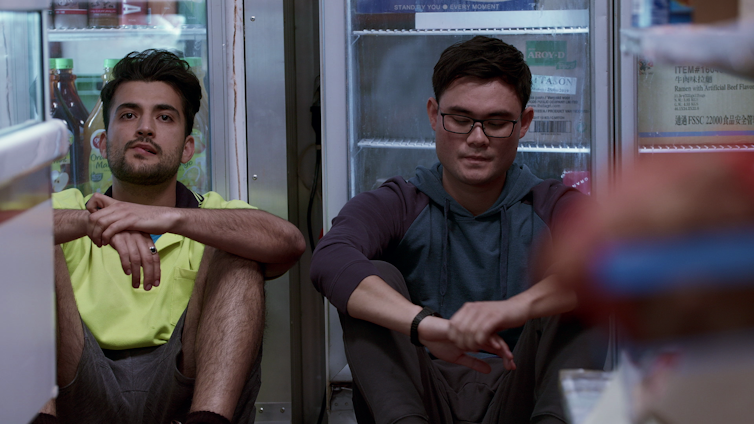Inside the story: the ABC of screenwriting as demonstrated by ABC's The Heights
- Written by Philippa Burne, Lecturer, BFA Screenwriting, Victorian College of the Arts, University of Melbourne, University of Melbourne
Why do we tell stories, and how are they crafted? In this series, we unpick the work of the writer on both page and screen.
The rule of three is a commonly held one for writers. It’s used for comedy (two relatively normal things are often followed by a third twist or stereotype), for rhythm, and it’s widely accepted that people remember things more clearly when listed in threes. Think of The Three Little Pigs, The Three Musketeers or Slip Slop Slap.
This rule of threes is also embedded deeply within television screenwriting. Writing episodic TV, scriptwriters traditionally work from a principle of having three stories woven together through an episode. These are known as the A story, the B story and the C story.
Newly launched in 2019, and already well received, the ABC’s half-hour series, The Heights, uses this threefold technique skilfully to establish characters and story world. By breaking down the pilot episode we can see how the three stories run through it.
Read more: The Heights - at last, a credible Australian working-class soap
A, B and C stories
The A story in TV drives the action, prompting the viewer to ask “What’s going to happen?” or “Who did it?”. The B storyline is typically more character-driven, or emotion-driven. The C story could be lighter, perhaps comedic, depending on the show.
The A story is the main thread of the episode, and will generally have the most plot points (or beats or scenes). The B story has fewer story beats per episode; the C story fewer still.
Plotting an episode involves working out the beats for each storyline, then weaving them together for satisfying narrative build, scene design and character development.
Wherever storylines cross over, or dramatically contrast or impact on one another, this will be carefully identified and structured to give the audience the strongest possible dramatic or comic experience.
In The Heights, The A story is that of an abandoned baby. The B story follows who will inherit the local pub. The C story explores a teenage boy’s choice about which parent to live with.
Other characters’ stories are also seeded in to be developed in later episodes - Claudia and Sabine’s arrival in town, Pav’s obtaining pain relief through marijuana, and Sully and Ash’s relationship – but these only have a single beat (within one scene).
Let’s take a look at the pilot episode, scene by scene, to uncover more about this ABC structure.
 The cast of The Heights.
Ben King/ABC
The cast of The Heights.
Ben King/ABC
Breaking down the ABC structure
The opening sequence sets up the world, and many of the characters, utilising soccer, a barbecue, and the fire alarm. The fire alarm pays off a couple of scenes later as having beena deliberate part of a plan to abandon the baby. (A story).
Hazel is set up as hoping to inherit the pub from her father, Bill, who has just died. It is her “lottery ticket”. (B story).
At the end of this sequence, Pav finds an abandoned baby in the garden. Pav rushes the baby to the hospital. Police search for clues as to the baby’s identity. (A story).
This scene also reveals that Pav is a retired, injured cop. He has to climb the stairs and .has leg pain, so he self-medicates with marijuana. His kids and ex-wife are established for the audience. Mich, his son, wants to stay with Pav rather than Leona, his mother. (C story).
This scene also cleverly keeps the A-story alive by featuring a news report of the abandoned baby – this technique is used across many scenes of the episode. So, it’s not necessarily new information for the A-story – though it might be – but is functioning to tie the characters and community together for the audience, and also give the characters information.
Claudia and Anna meet while nursing the abandoned baby. This scene also functions to further develop the world and interlink the characters through a common workplace. (A story). Claudia is home to her unpacked boxes and her daughter, Sabine, who is starting at the local high school the next day.
Hazel is opening the pub and a mystery man watches her. He is revealed to be her estranged son, Ryan, and the tension between them is established due to Ryan having stolen money from the pub and been gone 12 years. (B story). Also, his sister Shannon is established as having been gone for some weeks. Shannon will be revealed to be important to the A-story.
The grocery store is established, with its proprietor, Iris, her son Sully and his friend, Ash. Pav and Leona meet there and talk in the street about their kids. (C story).
 From left, Phoenix Raei (Ash) and Koa Nuen (Sully) in The Heights.
Bohdan Warchomij/AAP
From left, Phoenix Raei (Ash) and Koa Nuen (Sully) in The Heights.
Bohdan Warchomij/AAP
At the river, Ryan and Anna meet up. A possible rekindled romance is seeded, and the pub inheritance discussed. (B story). Shannon’s absence is mentioned.
At the beach, Pav hangs out with his kids. They discuss trying to find the mother of the baby, and also Mich’s living arrangements. (A,C stories).
Hazel plans to sell the pub and retire, and Ryan pays back the money. (B, A stories).
Clues to the baby’s mother are discussed by Pav and Max. A girl is watching Claudia nurse the baby. Claudia gives chase. (A story).
Bill’s wake is being held, and Hazel and Ryan begin to reconcile, before a lawyer arrives and tells Hazel that Bill left the pub in equal shares to Hazel, Ryan and Shannon. Hazel is furious. Then Shannon arrives and collapses. There is a big reveal - Shannon is the baby’s mother. (B,A stories).
Establishing themes
As this breakdown shows, the greatest number of story beats revolve around the episode’s A story: the abandoned baby. The mystery is solved by the end, the story having served its dramatic function in driving it while simultaneously connecting the characters and establishing the show’s world and recurring themes, namely parenting and family.
The B story has the next highest number of story beats. It has left major characters – Hazel and Ryan – with a dramatic legacy to be played out in future episodes (owning and running the pub). These estranged family members are now tied together in day-to-day responsibility.
The C story has the fewest number of beats, and begins another ongoing story about family and responsibility. It is less dramatic and immediate than the A and B stories, but has plenty of potential for emotional, long-term narrative – and future drama.
Authors: Philippa Burne, Lecturer, BFA Screenwriting, Victorian College of the Arts, University of Melbourne, University of Melbourne



